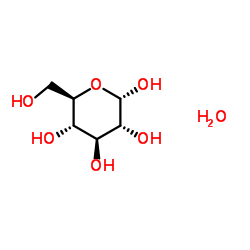5996-10-1
| 中文名 | 一水合葡萄糖 |
|---|---|
| 英文名 | D-Glucose monohydrate |
| 中文别名 |
一水葡萄糖
α-D-葡萄糖,一水 D-葡萄糖,一水 一水右旋糖 |
| 英文别名 |
α-d-Glucose hydrate
Corn sugar EINECS 200-075-1 (2R,3S,4R,5R)-2,3,4,5,6-pentahydroxyhexanal hydrate MFCD00150744 α-D-Glucopyranose hydrate (1:1) Dextrose,granular DEXTROSE USP MONOHYDRATE DEXTROSE MONOHYDRATE D-glucose monohydrate Glucose D-(+)-Glucose monohydrate D-glucose hydrate D-Glucose hydrate (1:1) C6H12O6.H2O α-D-Glucopyranose, hydrate (1:1) (2R,3S,4R,5R)-2,3,4,5,6-Pentahydroxyhexanalhydrat D-Glucose, hydrate (1:1) D-Glucose, monohydrate Dextrose,Hydrous,Powder,USP DextroseMonohydrateIp |
| 沸点 | 410.8ºC at 760 mmHg |
|---|---|
| 熔点 | 83ºC |
| 分子式 | C6H14O7 |
| 分子量 | 198.171 |
| 闪点 | 202.2ºC |
| 精确质量 | 198.073959 |
| PSA | 119.61000 |
| 外观性状 | 无色晶体或白色结晶粉末 |
| 储存条件 | 室温 |
Synonym:alpha-D-Glucopyranose, monohydrate; alpha-D-Glucose monohydarte; Dextrose monohydrate Section 2 - COMPOSITION, INFORMATION ON INGREDIENTS
Risk Phrases: None Listed. Section 3 - HAZARDS IDENTIFICATION EMERGENCY OVERVIEW
Not available. Potential Health Effects Eye: Dust may cause mechanical irritation. Skin: Dust may cause mechanical irritation. Low hazard for usual industrial handling. Ingestion: No hazard expected in normal industrial use. Inhalation: No hazard expected in normal industrial use. Inhalation of dust may cause respiratory tract irritation. Chronic: No information found. Section 4 - FIRST AID MEASURES Eyes: Get medical aid. Gently lift eyelids and flush continuously with water. Skin: Get medical aid if irritation develops or persists. Flush skin with plenty of soap and water. Ingestion: Get medical aid if irritation or symptoms occur. Inhalation: Remove from exposure and move to fresh air immediately. Get medical aid if cough or other symptoms appear. Notes to Physician: Section 5 - FIRE FIGHTING MEASURES General Information: As in any fire, wear a self-contained breathing apparatus in pressure-demand, MSHA/NIOSH (approved or equivalent), and full protective gear. Dusts at sufficient concentrations can form explosive mixtures with air. Extinguishing Media: Use water spray, dry chemical, or carbon dioxide. Section 6 - ACCIDENTAL RELEASE MEASURES General Information: Use proper personal protective equipment as indicated in Section 8. Spills/Leaks: Vacuum or sweep up material and place into a suitable disposal container. Avoid generating dusty conditions. Provide ventilation. Section 7 - HANDLING and STORAGE Handling: Minimize dust generation and accumulation. Storage: Store in a cool, dry, well-ventilated area away from incompatible substances. Section 8 - EXPOSURE CONTROLS, PERSONAL PROTECTION Engineering Controls: Good general ventilation should be sufficient to control airborne levels. Exposure Limits CAS# 5996-10-1: CAS# 14431-43-7: Personal Protective Equipment Eyes: Wear appropriate protective eyeglasses or chemical safety goggles as described by OSHA's eye and face protection regulations in 29 CFR 1910.133 or European Standard EN166. Skin: Protective garments not normally required. Clothing: Protective garments not normally required. Respirators: Follow the OSHA respirator regulations found in 29 CFR 1910.134 or European Standard EN 149. Use a NIOSH/MSHA or European Standard EN 149 approved respirator if exposure limits are exceeded or if irritation or other symptoms are experienced. Section 9 - PHYSICAL AND CHEMICAL PROPERTIES Physical State: Solid Color: white Odor: None. pH: 5.9 (0.5M) Vapor Pressure: Negligible. Viscosity: Not applicable. Boiling Point: Not available. Freezing/Melting Point: 295 deg F Autoignition Temperature: Not applicable. Flash Point: Not applicable. Explosion Limits, lower: Not available. Explosion Limits, upper: Not available. Decomposition Temperature: Not available. Solubility in water: Soluble in water. Specific Gravity/Density: 1.54 (water=1) Molecular Formula: C6H12O6 Molecular Weight: 180.0804 Section 10 - STABILITY AND REACTIVITY Chemical Stability: Stable under normal temperatures and pressures. Conditions to Avoid: Dust generation. Incompatibilities with Other Materials: Strong oxidizing agents. Hazardous Decomposition Products: Carbon monoxide, carbon dioxide. Hazardous Polymerization: Has not been reported. Section 11 - TOXICOLOGICAL INFORMATION RTECS#: CAS# 5996-10-1 unlisted. CAS# 14431-43-7 unlisted. LD50/LC50: Not available. Not available. Carcinogenicity: Deleted Registry Number replaced by 14431-43-7 - Not listed by ACGIH, IARC, or NTP. .alpha.-D-Glucopyranose, monohydrate - Not listed by ACGIH, IARC, or NTP. Section 12 - ECOLOGICAL INFORMATION Section 13 - DISPOSAL CONSIDERATIONS Products which are considered hazardous for supply are classified as Special Waste and the disposal of such chemicals is covered by regulations which may vary according to location. Contact a specialist disposal company or the local waste regulator for advice. Empty containers must be decontaminated before returning for recycling. Section 14 - TRANSPORT INFORMATION IATA Shipping Name: Not regulated. Hazard Class: UN Number: Packing Group: IMO Shipping Name: Not regulated. Hazard Class: UN Number: Packing Group: RID/ADR Shipping Name: Not regulated. Hazard Class: UN Number: Packing group: Section 15 - REGULATORY INFORMATION European/International Regulations European Labeling in Accordance with EC Directives Hazard Symbols: Not available. Risk Phrases: Safety Phrases: WGK (Water Danger/Protection) CAS# 5996-10-1: 0 CAS# 14431-43-7: No information available. Canada None of the chemicals in this product are listed on the DSL/NDSL list. CAS# 5996-10-1 is not listed on Canada's Ingredient Disclosure List. CAS# 14431-43-7 is not listed on Canada's Ingredient Disclosure List. US FEDERAL TSCA CAS# 5996-10-1 is not listed on the TSCA inventory. It is for research and development use only. CAS# 14431-43-7 is not on the TSCA Inventory because it is a hydrate. It is considered to be listed if the CAS number for the anhydrous form is on the inventory (40CFR720.3(u)(2)). SECTION 16 - ADDITIONAL INFORMATION N/A |
| 海关编码 | 17023051 |
|---|
| 海关编码 | 17023051 |
|---|


